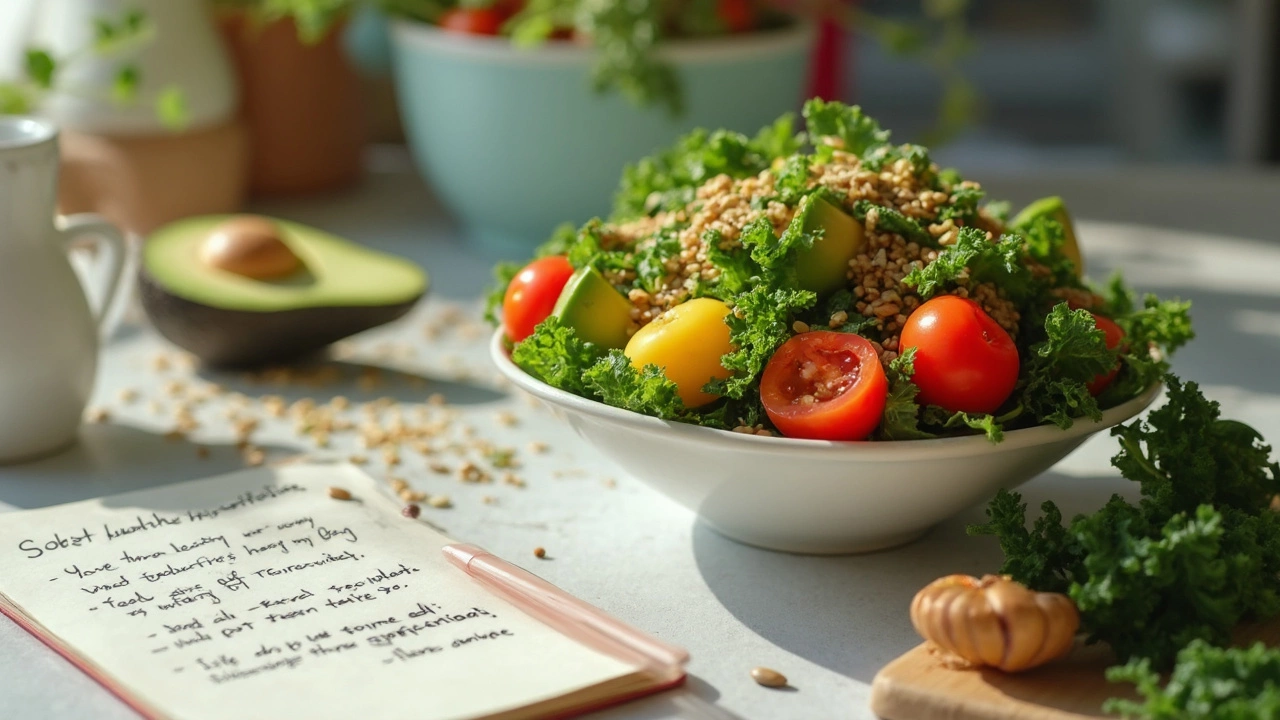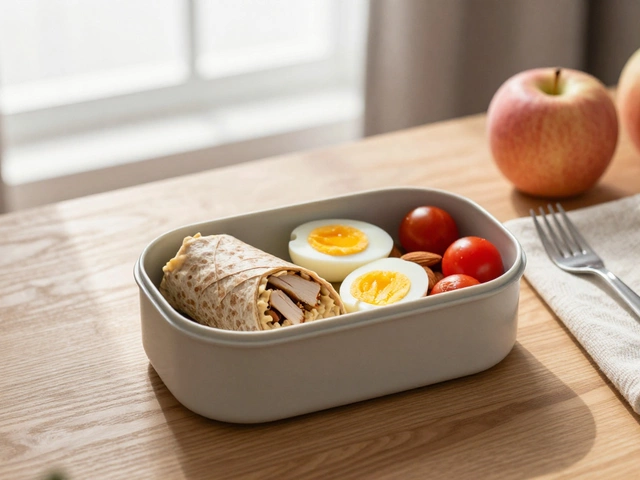
Stop scrolling through endless lists ranking "superfoods"—there’s one food almost every nutrition scientist points to as the king of health. It’s not some rare berry from the Amazon or the latest trend you saw in an influencer’s smoothie. It’s just a regular, affordable food you can find in any grocery store: spinach.
Yeah, spinach. It packs more nutrition per calorie than almost anything else you can put on your plate. Want iron, vitamin K, magnesium, fiber, a hit of antioxidants—all in a single serving? Spinach delivers it. No need to cook complicated dishes or hunt down exotic ingredients. Just toss a handful into a salad, blend it in a smoothie, or pile it onto a sandwich.
Most people miss out on these simple powerhouses because they think eating healthy means spending more money or time. You actually just need to add more spinach (or leafy greens in general) to what you’re already eating. It’s low-key, but it works, and the health benefits are serious.
- Why There’s No Universal Answer (But One Food Stands Out)
- Nutritional Facts: What Makes This Food a Champion
- Science-Backed Health Benefits
- Easy Ways to Add It to Your Daily Routine
- Quick and Simple Healthy Recipes
- What About Runners-Up? Other Foods Worth Noting
Why There’s No Universal Answer (But One Food Stands Out)
Ever notice how everyone seems to have a different answer for the healthiest food out there? One nutritionist swears by blueberries, another can't stop talking about salmon, and someone else is all about kale. The thing is, everyone has different needs—what’s good for a young athlete isn’t the same as what your grandma needs. Age, allergies, health goals, and even lunch cravings can change the game.
But despite all these differences, some foods keep showing up on those top health lists, year after year. Researchers at William Paterson University in New Jersey actually tried to settle the debate with a big nutrition study in 2014. They scored 41 fruits and veggies by nutrient density, and leafy greens dominated the list. Spinach was near the very top because of how much it delivers per bite—think protein, fiber, vitamins K, A, and C, plus minerals like magnesium and iron. It’s like nature’s multivitamin in a leaf.
Check this out—here’s a quick look at what a single cup of raw spinach gives you (all for less than 10 calories):
| Nutrient | Amount in 1 cup (raw) |
|---|---|
| Vitamin K | 144 mcg (120% DV) |
| Vitamin A | 2,813 IU (56% DV) |
| Folate | 58 mcg (15% DV) |
| Iron | 0.8 mg (5% DV) |
| Calories | 7 kcal |
That’s why, if you had to pick just one food to boost your nutrition without tons of effort, spinach would be the winner. It doesn’t mean you have to ditch every other fruit or veggie—variety matters! But spinach stands out for packing so much good stuff into so few calories, and that’s hard to ignore.
Nutritional Facts: What Makes This Food a Champion
So why does spinach top so many lists for the healthiest food? It comes down to what you actually get in each bite—and trust me, it’s a lot. Spinach is super low in calories. One cup of raw spinach only has about 7 calories, but it still fills you up thanks to the fiber.
Check out how stacked it is with the good stuff:
- Iron: Helps carry oxygen through your blood. Spinach isn’t just for cartoon musclemen—it genuinely boosts your energy.
- Vitamin K: Crazy high. One cup gives you more than your daily need, which is key for bone strength and helping your blood clot right.
- Vitamin A: Supports your immune system and eyesight.
- Magnesium and potassium: Both help your muscles work and keep your blood pressure in check.
- Folate: Super important for healthy cell growth, especially if you’re expecting a baby.
- Antioxidants: Lutein, zeaxanthin, and beta-carotene do a whole lot for fighting off cell damage and protecting your vision.
If you want some hard numbers, here’s what you get from a single cup of raw spinach:
| Nutrient | Amount per cup (raw) | % Daily Value |
|---|---|---|
| Vitamin K | 145 mcg | 120% |
| Vitamin A | 2,813 IU | 56% |
| Folate | 58.2 mcg | 15% |
| Magnesium | 24 mg | 6% |
| Potassium | 167 mg | 5% |
| Iron | 0.8 mg | 5% |
What really stands out is how you get all these nutrients while still keeping calories crazy low. That means you can load up your plate and actually feel full without overdoing it.
For anyone who’s picky, swapping iceberg lettuce for spinach in sandwiches or tossing a handful into hot pasta gives your meal a major nutrition boost—without changing up the flavor much. No kitchen heroics needed.
Science-Backed Health Benefits
Spinach isn’t just another green thing on your plate. Its health perks are backed by a stack of solid studies, not just hype. For starters, spinach is loaded with nutrients that people tend to miss—think iron, potassium, vitamin K, folate, and loads of antioxidants. These bits help keep your energy up and your immune system firing on all cylinders.
Research from Harvard and the CDC points out that folks who regularly eat spinach or similar leafy greens have a way lower risk of heart disease and strokes. That’s partly because the potassium in spinach helps your body balance blood pressure, and the fiber keeps your cholesterol in check. One cup of cooked spinach gives over 500% of your daily vitamin K, which your bones use to stay strong and resilient.
Trying to keep your eyes healthy? Spinach has lutein and zeaxanthin—these are antioxidants that protect your eyes from damage and lower the risk of macular degeneration and cataracts as you age. Even the small stuff counts; the nitrates in spinach help your blood flow better and can even boost your energy if you eat it before a workout.
| Spinach Nutrition (per 100g, cooked) | Amount |
|---|---|
| Calories | 23 kcal |
| Protein | 2.9 g |
| Vitamin K | 483 mcg (over 500% DV) |
| Iron | 3.6 mg |
| Magnesium | 79 mg |
| Potassium | 558 mg |
Don’t just take my word for it. Next time you see spinach tossed in a salad or cooked into a dish, remember you’re not just getting flavor. You’re hitting a serious nutrition jackpot and helping your long-term health in ways most foods can’t match.

Easy Ways to Add It to Your Daily Routine
If you want to start eating the healthiest food more often, you don’t need to change your whole menu. Small swaps and quick tricks can get more spinach—or any leafy greens—into your diet.
- Toss it into smoothies: Baby spinach blends super easily and you won’t taste it—especially with banana or peanut butter. It’s an effortless way to bump up the nutrition in your morning.
- Mix it with eggs: You can throw a handful into scrambled eggs or an omelet right before you finish cooking. It wilts quickly and adds both color and vitamins.
- Swap it for lettuce: Layer spinach on sandwiches, burgers, or wraps instead of iceberg lettuce. You’ll get way more vitamins and fiber, and the texture is great.
- Add it to soups and stews: Near the end of cooking, stir in spinach until it wilts. This works for everything from chicken noodle soup to chili.
- Bulk up pasta and rice dishes: Just before serving, mix in a few cups of spinach. The heat from the food cooks it down instantly, and you barely notice it’s there.
- Create quick salads: The easiest option—toss fresh spinach leaves with olive oil, lemon, and a pinch of salt. Add whatever’s in the fridge: nuts, cheese, leftover chicken, or roasted veggies.
If you’re wondering how much spinach makes a difference, here’s a quick look:
| Serving Size | Calories | Fiber | Vitamin K (% Daily Value) | Magnesium (% Daily Value) |
|---|---|---|---|---|
| 1 cup raw | 7 | 0.7g | 121% | 6% |
| 1 cup cooked | 41 | 4.3g | 987% | 39% |
Spinach is low in calories but high in pretty much everything your body needs. The more you toss it in, the more you boost your daily dose of nutrition with little effort. Even just sneaking a handful here or there adds up fast over a week.
Quick and Simple Healthy Recipes
If you’re not sure how to make spinach more exciting, you’re in the right place. Here are a few healthy recipes using spinach, and you don’t have to be a chef—promise.
- Easy Spinach Omelet
Break two eggs in a bowl, whisk, toss in a big handful of fresh spinach, and cook in a non-stick pan. Add a splash of milk or cheese if you want. In less than 10 minutes, you get a protein-packed breakfast with all the benefits of dark leafy greens. - One-Bowl Spinach Salad
Throw washed fresh spinach in a bowl. Add sliced strawberries or apple, a sprinkle of walnuts, and a dash of feta cheese. For dressing, just mix olive oil and a bit of lemon juice. Simple, fiber-rich, and loaded with vitamins. - Super Easy Green Smoothie
Toss a cup of fresh spinach, one ripe banana, half an apple, and a cup of unsweetened almond milk into a blender. Blend until smooth. That’s it. You’ve got an instant way to boost your daily dose of nutrition and start your day feeling full of energy. - Spinach Stir-Fry Side
Heat olive oil and garlic in a skillet, then toss in a whole bag of spinach. Stir until it wilts, hit it with a splash of soy sauce, and you’ve got a five-minute iron-rich side dish that goes with absolutely anything.
If you like numbers, spinach really holds up. Check out how it compares to some other greens:
| Vegetable | Iron (mg/100g) | Vitamin K (mcg/100g) |
|---|---|---|
| Spinach (raw) | 2.7 | 483 |
| Romaine Lettuce | 1.2 | 102 |
| Kale | 1.5 | 389 |
There’s no special skill required for these dishes. Just use what you’ve got, and you’ll get a big health payoff from every bite. Add spinach to your usual recipes and you’re scoring major points for a balanced diet.
What About Runners-Up? Other Foods Worth Noting
Sure, spinach wears the crown, but some other foods come close in the nutrition game. If you want to switch things up or round out your diet, you’ve got legit options that can boost your healthy recipes without much effort.
Let’s run through a few of the best challengers to spinach:
- Salmon: This fish is loaded with Omega-3 fatty acids—good for your heart, your brain, and even your mood. Just two servings a week are what doctors recommend for the biggest benefits. Look for wild-caught if you can find it.
- Blueberries: They’re famous for antioxidants, but they also pack vitamin C and fiber. Studies have shown folks who regularly eat blueberries may have better memory as they get older.
- Lentils: These tiny beans are a powerhouse of plant protein, plus they’ve got iron and a ton of fiber. They cook fast, work in soups, salads, and even can take the place of meat in tacos or burgers.
- Eggs: Everyone goes back and forth on eggs, but the facts say they give you high-quality protein, vitamin D, and important nutrients like choline, which helps your brain.
- Greek Yogurt: Super high in protein and good bacteria for your gut. Go for plain, unsweetened types to dodge extra sugar.
- Broccoli: Kind of a cousin to spinach, loaded with vitamin C, fiber, and compounds that may help protect against some cancers. Roasted, steamed, or even raw, it’s easy to add somewhere in your day.
Check out how these foods stack up by nutrition (per 100g):
| Food | Protein (g) | Fiber (g) | Main Vitamins |
|---|---|---|---|
| Salmon | 20 | 0 | B12, D |
| Blueberries | 0.7 | 2.4 | C, K |
| Lentils | 9 | 8 | B6, Folate |
| Eggs | 13 | 0 | D, B12 |
| Greek Yogurt | 10 | 0 | B12 |
| Broccoli | 2.8 | 2.6 | C, K |
Mixing foods like these into your meals keeps things interesting, helps balance your nutrition, and brings extra health perks to your routine. If you’re tired of the same salad every day, try swapping in lentils or topping it with a soft-boiled egg. Sometimes the best superfoods are the ones already in your fridge.





